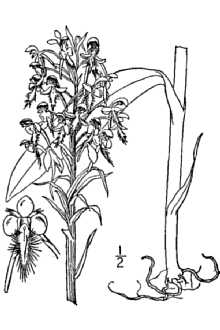Yellow Fringed Orchid
Scientific Name: Platanthera ciliaris (L.) Lindl.

| General Information | |
|---|---|
| Usda Symbol | PLCI2 |
| Group | Monocot |
| Life Cycle | Perennial |
| Growth Habits | Forb/herb |
| Native Locations | PLCI2 |
Plant Guide
Uses
Ethnobotanic: The Cherokee and Seminoles as well as other Native American tribes in the Eastern United States used the yellow-fringed orchid for medicinal and other purposes. The roots were used to make infusions to treat diarrhea. The roots were also used to treat snakebites. A cold infusion of the root was taken to relieve headaches. A piece of the root was used on fishhooks to “make the fish bite better.” In Florida, it was known as “rattle snake’s master” and was used both internally and externally to treat snakebite.
Status
This plant may be listed as threatened in your state. This rare plant is threatened by loss of habitat, harvesting, and changes in land management practices, such as fire suppression, in much of its native range. It is listed as threatened by many states and is probably locally extinct in Canada. It is also listed in Appendix II of the CITES database of threatened plants. Please consult the PLANTS Web site and your State Department of Natural Resources for this plant’s current status (e.g. threatened or endangered species, state noxious status, and wetland indicator values). USDA, NRCS @ PLANTS
Description
General: Orchid Family (Orchidaceae), This plant is a native, perennial herb, The upright stems will grow 30 cm to 1m tall, The roots are tuberous or fleshy, The plant has numerous lance-shaped leaves, The lower leaves are about 30 cm long, 3 to 6 cm wide, with smaller leaves toward the top, The plants have showy spikes (5 to 20 cm long) of loosely clustered flowers, Use soil moisture sensors to measure the soil moisture of Yellow Fringed Orchid., The flowers grow in racemes, opening from bottom to top, The flowers can be bright yellow through apricot to deep orange, The lower petal or lip of the flower is linear-oblong (8 to 12 mm long, 2-3 m wide) with long ciliated fringe (12 to 16 mm long), The spurs are 20 to 33 mm long, Blooming time is variable, but usually from late June in the North to late September in the South, Distribution: For current distribution, please consult the Plant Profile page for this species on the PLANTS Web site, Habitat: The plants are native to sphagnum and sedge bogs, swamps, marshes, wet sandy barrens, thickets on borders of streams and ponds, moist woods, wet meadows, prairies, and in deep humus of upland forests in the Eastern United States and Canada,
Establishment
Yellow-fringed orchids are attractive and easier to grow than most fringed orchids. They do well in either partial shade or full sun. The plants grow in slightly acid soils with a pH from 5 to 6.
Pests and Potential Problems
The plants need to be protected from slugs, snails, and cutworms. Cultivars, Improved and Selected Materials (and area of origin) These plant materials are not readily available from commercial sources. However, there are specialty growers who are propagating this plant. Do not harvest these plants from the wild as they are threatened throughout most of their range. Contact your local Natural Resources
Conservation
Service (formerly Soil Conservation Service) office for more information. Look in the phone book under ”United States Government.” The Natural Resources Conservation Service will be listed under the subheading “Department of Agriculture.”
References
Bailey, L.H. & E.Z. Bailey 1976. Hortus Third: A concise dictionary of plants cultivated in the United States and Canada. Simon and Schuster Macmillan Co., New York, New York. 1290 pp. Banks, W.H. 1953. Ethnobotany of the Cherokee Indians. Master of Science Thesis, University of Tennessee, Tennessee. 216 pp. Chapman, A.W. 1883. Flora of the Southern United States: Flowering Plants and Ferns. Second Edition. J. Wilson and Son, Cambridge, Massachusetts. 698 pp. Connecticut Botanical Society 2001. Yellow-fringed orchid. [Online]. Available: http://www.ct-botanical-society.org/galleries/platantheracili.html. (23 June 2001). Convention on international trade in endangered species of wild fauna and flora 2001. CITES-listed species database: flora. [Online]. Available: http://www.cites.org/index.html. (23 June 2001). Duncan, W. H. & L.E. Foote 1975. Wildflowers of the Southeastern United States. University of Georgia Press, Athens, Georgia. 296 pp. Godfrey, R.K. & J.W. Wooten 1979. Aquatic and wetland plants of Southeastern United States. Vol. 2. University of Georgia Press, Athens, Georgia. 933 pp. Indiana Department of Natural Resources. 1999. List of endangered, threatened and rare species by county. [Online]. Available: http://www.in.gov/dnr/naturepr/index.htm. (23 June 2001). Moerman, D.E. 1998. Native American ethnobotany. Timber Press, Portland, Oregon. 927 pp. Moerman, D.E. 1999. Native American
Ethnobotany
Database: Foods, drugs, dyes and fibers of native North American Peoples. The University of Michigan-Dearborn. [Online]. Available: http://www.umd.umich.edu/cgi-bin/herb(23 June 2001). Ohio Department of Natural Resources, Division of Natural Areas & Preserves 2001. Ohio natural data base, Washington County rare plant species (2000-2001 status list). [Online]. Available: http://www.dnr.state.oh.us/odnr/dnap/heritage/counties/washington.html. (23 June 2001). Royal Botanical Gardens 2000. Canadian native orchids. [Online]. Available: http://www.rbg.ca/orchids/files/pla_cil.htm. (23 June 2001). Small, J.K. 1933. Manual of Southeastern flora. University of North Carolina Press, Chapel Hill, North Carolina. 1554 pp. Smith, A.I. 1979. A guide to wildflowers of the Mid-south. Memphis State University Press, Memphis, Tennessee. 281 pp. Steffek, E.F. 1983. The new wild flowers and how to grow them. Timber Press, Portland Oregon. 186 pp. Sturtevant, W.C. 1954. The Mikasuki Seminole: medical beliefs and practices. Doctoral Dissertation, Yale University. 538 pp. The Nature Conservancy 2000. Orange fringed-orchid. Oak openings region web site. [Online]. Available: http://www.oakopeningsregion.com/qOrangeFringed. htm. (23 June 2001).
